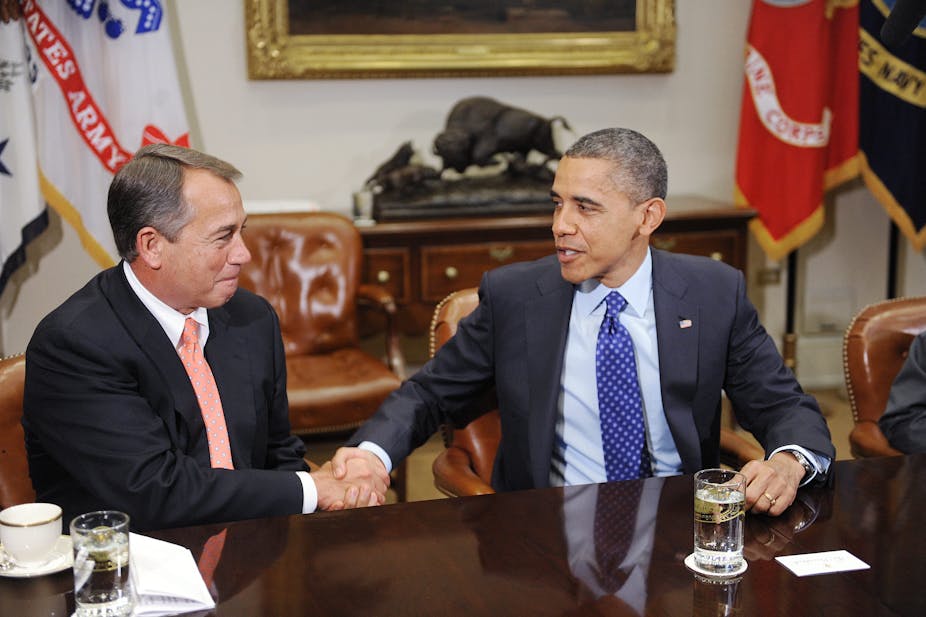Different year, same crisis. Around this time last year, the United States was looking down the barrel of economic disaster with the debt ceiling. As we approach 2013, it peers over the fiscal cliff.
That feeling has characterised 2012. Events from 2011 - such as the Eurozone sovereign debt crisis - have continued their relentless rush this year, morphing into other deeper consequences.
While last year entire nations stood on the brink (and continue to), this was the year when citizens bore the brunt of austerity cuts they were told they must endure.
While banks finally now feeling the consequences of activities which took the global economy to the brink, there is a feeling that despite doling out record-breaking fines, regulators seem unable to fully grapple with reforming a global system utterly divorced from the public good, writes UNSW Professor of Law, Justin O'Brien.
“The societal cost of the break between stated and lived values exposed in the Libor scandal poses a series of fundamental questions. Can corporate culture be regulated? If so, should it? How does one ensure the continuing accountability of regulatory intervention?”

And at home, a reality check: Australia is not immune to the global conditions.
Falling commodities prices and declining tax revenues has already pushed some debt-saddled states to begin deep - and unpopular - cost cutting measures, while the Federal Government has finally abandoned its dogged pursuit of a budget surplus.
These changing times will test the mettle of Australia’s mining barons, wrote Jason West.
History is replete with entrepreneurs who saw opportunity and invested their personal wealth and reputation at a critical period but failed to adjust when the global economy shifted.
This year was also the year of a deepening productivity debate, further emphasis on tax reform - including calls for a change to the GST and corporate tax rates - and some hard thinking about our manufacturing industry.
UTS Professor Roy Green, who headed the Prime minister’s Manufacturing Taskforce saw positivity; others took a more hard-headed approach, particularly to the car industry.

And it was also the year of mining barons coveting media interests and hard decisions for Australia’s media.
For The Conversation, a pivotal piece by founder Andrew Jaspan, ‘Fairfax or Gina-fax? Let’s have the debate before it’s over’ helped to further cement our presence and kicked off one of our most important series.
Also grappling with technology advances, Australian retailers could no longer ignore the online revolution that was threatening to leave it behind.
Irrespective of the politics which surround it, Julia Gillard’s misogyny speech, as it’s come to be known, was a game-changer which has galvanised public debate on women in leadership positions.
Readers of The Conversation’s business section will already be familiar with this debate, from new research on quotas, an examination of women on boards and in executive positions, the good news and the bad.

Earlier this year Eva Cox responded to a controversial story in The Atlantic magazine by Anne-Marie Slaughter titled 'Why women still can’t have it all’. Economists know that there are always scarce resources, Cox wrote:
“…but why are women of child bearing age still having to limit their choices? All we ask is that our choices were not constrained by gender, which seems a feasible aim.”
This year, The Conversation collaborated with the Centre for Applied Microeconomic Analysis (CAMA) to publish the monthly deliberations of its Shadow Board, made up of academic and practising economists, prior to the Reserve Bank of Australia’s board meeting. This is much more than the familiar guessing exercise we see in the media: as ANU Professor Shaun Vahey explains, the study is an “exercise in control, not forecasting”.
It aims to resolve two outstanding issues: first, can individual Board members quantify their uncertainty about the appropriate target cash rate with probabilities?
Second, can the risks envisaged by individual decision-makers be aggregated to give a collective view about the appropriate cash rate?“
Finally, it’s always fraught picking favourites but these particularly grabbed us this year:
Obama’s fiscal ‘grand bargain’ is a great betrayal of America’s most vulnerable: As the fiscal cliff looms, American exceptionalism may have reached its economic limits. This piece is a sharp analysis on how America’s most vulnerable risk being betrayed by a fiscal cliff deal.
VIDEO SERIES: Some Sports Economics: An entertaining series that combines sports and first-year microeconomics.
Let’s turn it up to 11: why audio quality loses out in the loudness wars uses Keynesian economics to illustrate market failure in the long-running "loudness wars” between record companies. A cracking read with a counter-intuitive premise: that technology has made sound quality more inferior over time.
Thanks to all our authors for the thought-provoking analysis, opinion and research we have published this year. We believe it has added much-needed depth the debate. And, of course, thanks to all our readers - we’ve had a cracking year.
Top five stories of the year:
Fairfax or Gina-fax? Let’s have the debate before it’s over
Malcolm Fraser: Does it matter who owns our papers? Yes it does
Killing the Kodak moment … is the iPhone really to blame?
Iron ore prices continue to fall, but is it really time to panic about China?
The anatomy of the resource boom tells us it’s only going to get better for taxpayers

